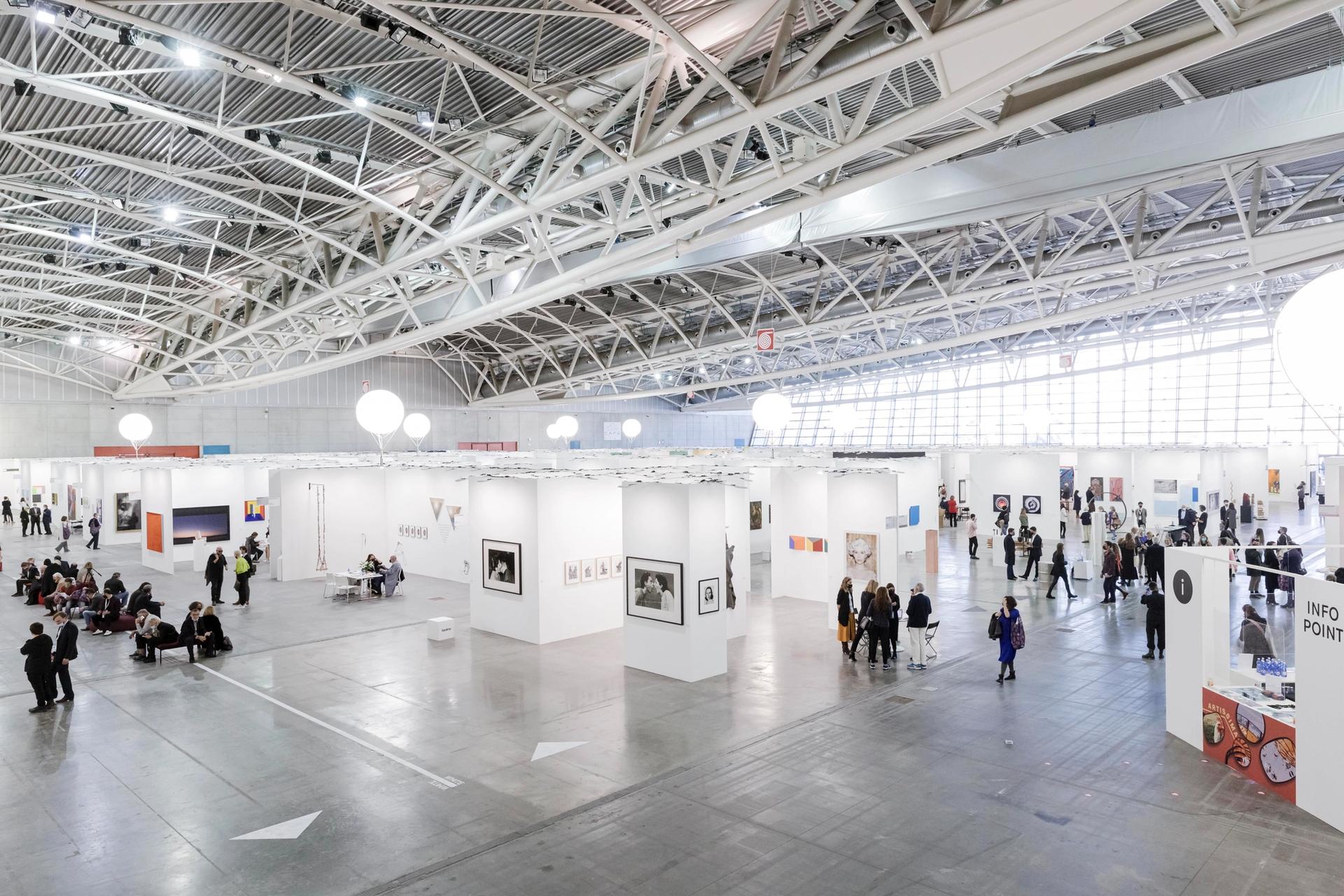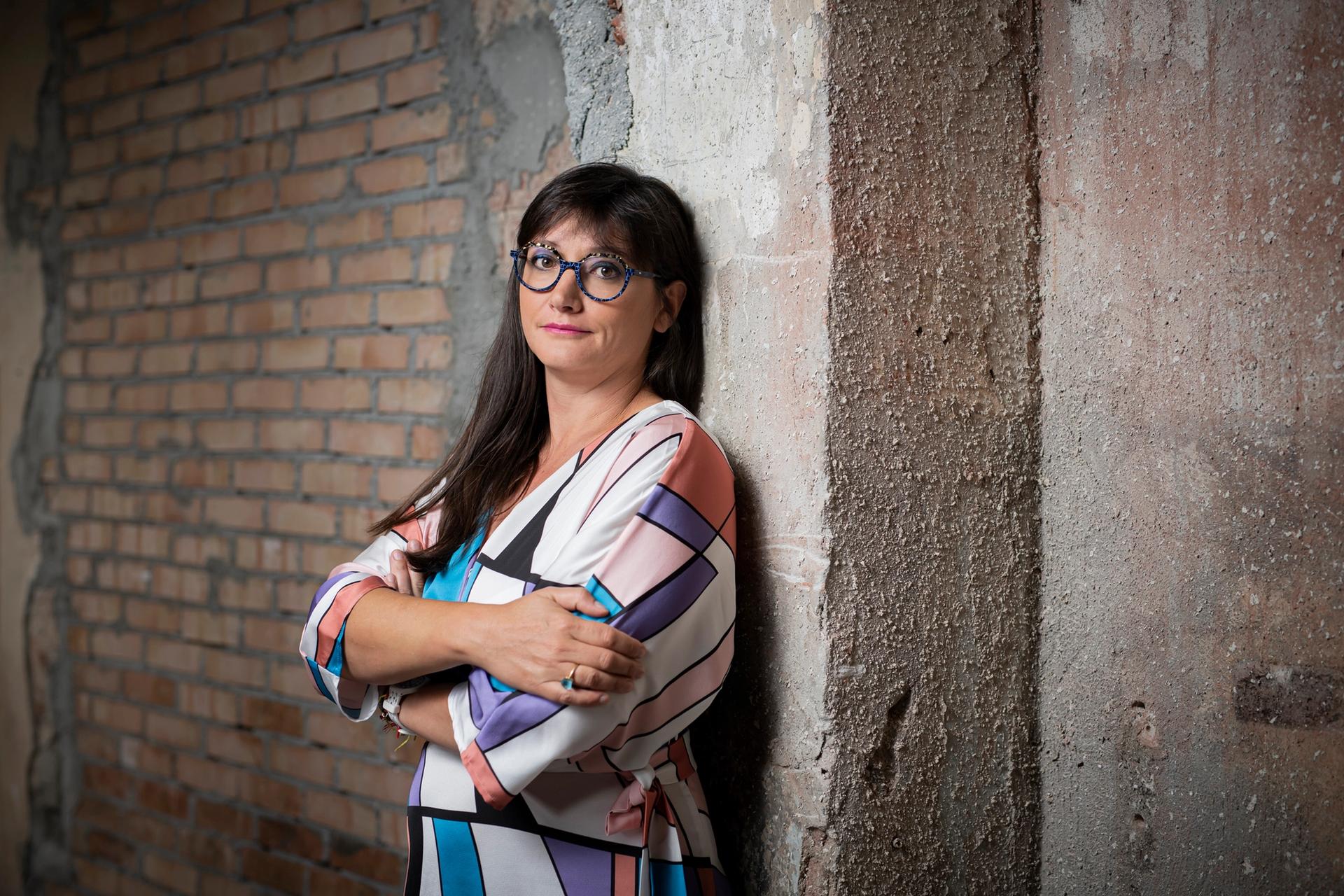The 28th edition of Artissima (until 7 November) in Turin—Italy’s only fair entirely devoted to contemporary art—opens to the public today, bringing 157 galleries to the Piedmont capital. This number is down from the 201 galleries that showed at its previous edition in 2019 (last year being cancelled due to the pandemic).
This reduction was made to accommodate social distancing measures in the vast Turin Oval Olympics skating hall, where the aisles have been widened by one meter. The exhibitor makeup remains much the same: largely Italian (just under 50%) with a strong representation of galleries from Germany, France and Austria and, somewhat curiously, Iran.
Yesterday’s preview saw mild, measured activity: Paris gallery Jocelyn Wolff moved sculptures by Francisco Tropa and Clemens Von Wedemeyer for €25,000 and €30,000 respectively and Repetto, based in London, placed a 2018 painting by Arte Povera artist Pier Paolo Calzolari into a private Italian collection for €32,000.
Turin’s most prolific art patron, the collector Patrizia Sandretto Re Raudebengo, bought (among other works) a large painting by the 28-year-old Czech artist Vojtěch Kovařík, from Mendes Wood DM, that was shown in one of the fair’s three curated sections which effectively function as commercial exhibitions.

Artissima is held in the Torino Oval, a skating hall built in 2006 to host the Olympic Winter Games. Photo courtesy: Perottino-Piva / Artissima
Preview day sales reached a ceiling of around €45,000, and there were not the rushed announcements of sold out booths seen at fairs like Art Basel and Frieze. But this is typical of Artissima and the collecting base it serves. In Piedmont, the birthplace of the slow cooking movement, art purchases require more time than at other autumn fairs. Visitors stroll, rather than pace, around the halls and they stop for lengthy conversations. The atmosphere is convivial and the queue for a focaccia sandwich takes around 45 minutes.
“They take their time the Italians. Closing a deal is often a three or four day process,” says Javier Peres, the director of Peres Projects based in Berlin, which has brought three paintings and one large steel sculpture by Chicago-born, Berlin-based Donna Huanca (her prices begin at €21,000, upper end not disclosed). Peres is one of several dealers present who are now on their fourth or fifth major art fair in two months, and like many others will soon be “rethinking” his fair strategy. Naturally this begs the question as to whether a fair like Artissima, which lacks the immediate competitive market edge of Fiac or Frieze, can survive the impending streamlining of the art world calendar.
“No one sells quickly or, for that matter, well at Artissima—everyone knows that,'' says an Italian dealer who prefers to remain anonymous. “But collectors will always come, and so galleries must too—few fairs are this well-curated or beautiful, or have this much of an institutional presence.”
This is a sentiment echoed by many dealers and collectors. “This is our first time here. We came to Artissima because of its reputation for being receptive to conceptually challenging works,” says Alexander Caspari, the director of Encounter gallery from London, which is showing a solo booth of works by the American artist Alexis Teplin (prices range from €2,250 to €15,000). “You always get prestigious, international curators and museum heads here,” he adds. Among the well known curators in attendance yesterday were Diana Campbell Betancourt, the organiser of the Dhaka Art Summit, Aaron Cezar, the director of London’s Delfina Foundation, and Krist Gruijthuijsen, the director of KW Institute for Contemporary Art in Berlin.
Artissima, which is partially state-funded by the museums association of Turin, also continues its tradition of programming around Piedmont’s art institutions. This year, an Indian theme sees a selling booth at the fair of 10 Indian galleries, and three exhibitions of Indian art are on show in public museums around Turin.

Artissima director Ilaria Bonacossa. Photo: Giorgio Perrotino
“We occupy a special position in this ecosystem,” says Artissima’s director Ilaria Bonacossa. “We market ourselves as the biggest of the small fairs, and the smallest of the big fairs”. Now on the final edition of her five year tenure at Artissima’s helm, Bonacossa says she is undecided as to whether she will reapply for the role next year. Nonetheless she is confident of the fair’s staying power: “It’s been a long time coming for art fairs to have their reckoning, but Artissima has always known its brand. Prices here are relatively low, rarely do they go above €100,000. Instead the art is relatively experimental, we have established ourselves as the European fair where you scout new talent”. True to form, this year’s edition marked the fair debut for a number of young artists such as 25-year-old painter Andrea Fontanari, brought by Boccanera, and Turin-based Giuseppe Mulas (born 1995) at Peola Simondi.
Artissima is also making inroads into digital sphere, and is the first major fair to launch an NFT prize, giving €8,000 to five artists at the fair to create an NFT work. One work will then be awarded this year’s OGR Prize, and will be acquired by Fondazione per l’Arte Moderna e Contemporanea CRT as part of the foundation’s permanent collection.
Noticeably absent from the fair, as they have been all season in Europe, are Asian collectors (Hong Kong-based Jonathan Cheung a notable exception). “Usually we have a strong number of Asian collectors. We put the fair on during truffle season because Chinese buyers want to come here to eat tartufo alba and buy art,” Bonacossa says.
But votes of confidence in Turin's art scene from Europeans are evident both in and around the fair. Tornabuoni, which has spaces in Paris, Milan and Florence, is returning after a three year gap, during which time it showed at Turin's Flashback fair, Artissima’s competitor which runs concurrently this weekend. The gallery are showing works by three 20th-century Italian artists, Alighiero Boetti, Piero Dorazio and Emilio Isgrò, with prices at the upper end of Artissima’s range, from €70,000 to €550,000. By the end of the preview day, four works were “in talks”, but none had sold, naturally.
Also contributing to Turin's buzz is the temporary presence of a London gallery not showing at the fair: Saatchi Yates. Founded last year by Arthur Yates and his wife Phoebe Saatchi Yates, the daughter of the art collector Charles Saatchi, the gallery has opened a three-week-long pop-up space in the city. “Although unexpected, it felt like a natural place to open a gallery and bring new blood to a city full of spirited, devoted collectors”, they say.
Yet despite containing what is by many accounts a thriving contemporary scene, Turin is still subject to onerous Italian export laws and a VAT tax rates which, at 22%, is one of the highest in Europe (to compare, VAT on art is 5% in Uk, 5.5% in France and 7% in Germany). “In my first year showing here the taxes killed me,” says Justin Rhodes, a director of Whatiftheworld, based in Cape Town, South Africa which is now on its second edition of Artissima. “But if we come back next year we plan to show artists who make work in residency in Italy to avoid importing costs.”
Other dealers use different tactics. Inès Lombardi, the director of Georg Kargl gallery in Vienna, says that collectors often purchase works in Austria, “where taxes are much, much lower” after seeing them in the fair. “Artissima is for us less about the act of selling than it is about starting conversations, these things are a gradual process here.”
It is not only sales that take time, but relationships too. “No one wants to buy from a gallery that is here one year and gone the next” says Mohammed Hafiz, the director of the Jeddah-based gallery Athr, which now on its fifth edition of Artissima and this year shows works by Sara Abu and Mohammad Al Faraj "It has taken a few years for some collectors to warm up to us," Hafiz adds.
Indeed, it seems that the slow and steady approach prevails. “This is the only fair in Europe that I attend every day until the Sunday," says the Brussels-based art fair advisor Eva Ruiz. "And sure, the figures aren’t fantastic, but from what I hear, galleries are rarely upset if they don’t sell here. Artissima is all about the institutional relationships you foster, and that is done over three or four years.”
It might seem strange—and perhaps a tad naïve—to conceive of a fair as not being all about sales. But overwhelmingly, dealers convey that their willingness to return year after year to Artissima is because of an atmosphere that is not found elsewhere. “Communications are efficient, staff are well taken care of and we are given food—and Italians know good food,” says one gallerist. It might seem revolutionary in the dog-eat-dog commercial art world, but perhaps one way a fair can ensure its longevity during turbulent times is not only being conducive to immediate sales, but treating its exhibitors with respect.


